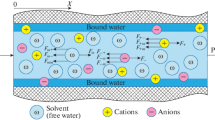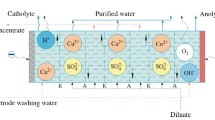The general stages of application of modeling of mass transfer of substances through a membrane in solution separation process for designing industrial apparatuses are presented. Numerical values of empirical coefficients are obtained to calculate friction coefficients of solvent–membrane, solute–membrane, and solute–solvent systems for anode-adjacent and cathode-adjacent membranes for separation of model aqueous CuSO4, Fe(NO3)3, and Ni(NO3)2 solutions of engineering industries.




Similar content being viewed by others
References
E. V. Levin, R. F. Sagitov, V. D. Bashirov et al., “Optimum ways of updating existing wastewater treatment systems of Sakmara thermal power plant.” Izv. Orenburg. Gos. Agrar. Univ., 68, No. 6, 220–222 (2017).
B. A. Lobasenko, R. V. Kotlyarov, E. K. Sazonova et al., “Improvement of technology of dairy stock processing using a new type of membrane apparatuses,” Tekhn. Tekhnol. Pisch. Proizvod., 49, No. 4, 587–593 (2019).
N. N. Kislenko and A. D. Troinikov, “Experience of application of membrane technology of gel extraction for designing facilities of Chayanda oil and gas condensate fields (OGCF),” in: Efficient Management of Complex Oil and Gas Projects (EPMI-17): Paps. Fifth International Scientific-Practical Seminar, in 2 parts (2017), pp. 166–168 .
K. I. Kiselev, K. V. Shestakov, I. V. Khorokhorina et al., “Modeling of phenomena of transfer of substances in electrochemical membrane processes based on friction theory,” in: Paps. Fifth International Scientific-Practical Seminar “Virtual Simulation. Prototyping. and Industrial Design,” Izdatel. Tsentr FGBOU VO TGTU, Tambov. Vol. 1 (2018), pp. 137–143 .
K. V. Shestakov, S. I. Lazarev, A. A. Arzamastsev et al., “Method for predicting and calculating friction coefficients and kinetic characteristics for electrodialysis separation of industrial solutions containing nickel ions,” Khim. Neftegaz. Mashinostr., No. 6, 10–13 (2019).
K. V. Shestakov and S. I. Lazarev, “Method for calculating rational process parameters for electromembrane purification of industrial solutions and wastewater in the chemical industry,” Khim. Neftegaz. Mashinostr., No. 1, 37–40 (2019).
K. V. Shestakov, S. I. Lazarev and K. K. Polyanskii, “Study and method of calculating the heat and temperature in an electrodialysis device during purification of galvanization industry wastewater,” Khim. Neftegaz. Mashinostr., No. 9, 15–18 (2019).
A. A. Shevtsov, A. A. Derkanosova, A. A. Korotaeva et al., “Influence of design features of turbulator of membrane apparatus on hydrodynamics of ultrafiltration process,” Nauch. Zh. NIU ITMO, Ser. Prots. Apparaty Pisch. Proizvod., No. 3, 81–90 (2015).
Author information
Authors and Affiliations
Corresponding author
Additional information
Translated from Khimicheskoe i Neftegazovoe Mashinostroenie. Vol. 56. No. 3, pp. 7–10, March, 2020.
Rights and permissions
About this article
Cite this article
Shestakov, K.V., Lazarev, S.I. & Khokhlov, P.A. Application of Modeling of Mass Transfer of Substances through Membrane for Designing Industrial Electromembrane Apparatuses. Chem Petrol Eng 56, 176–181 (2020). https://doi.org/10.1007/s10556-020-00756-1
Published:
Issue Date:
DOI: https://doi.org/10.1007/s10556-020-00756-1




